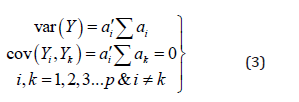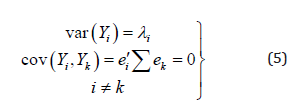Authored by Matthew Chukwuma Michael*
Abstract
The factors affecting ovulation interval, like another biological phenomenon are numerous and interdependent. This paper identified the factors to include Age, Height, Weight, Work Time (Stress), Menstrual Duration, Number of Conceptions, Number of Births and Exposure to Sun. It is the aim of this paper to formulate a smaller number of independent random variables such that minimum information is lost. A total of two hundred (200) women in their reproductive age interval were selected for the study. Questionnaires were used to get the relevant information from them. Eighty eight percent (88%) of the total variation in the ovulation interval was accounted for by six (6) principal components compared to the original eight random variables. It was observed that the most important factors are Stress, Height, Menstrual Duration, Weight and Age, and that only Exposure to Sun did not show any significance in affecting Ovulation Interval.Keywords:Principal Component; Ovulation; Conception; Factors and multivariate
Introduction
The time between two menstrual flows in which egg is released from the ovary into the fallopian tube in readiness for fertilization is called ovulation [1]. Being able to determine the period of ovulation is one of the major challenges to conception and unwanted/unexpected conception. The general believe is that ovulation occurs halfway into the normal menstrual cycle. There are signs and symptoms of ovulation which can help to notice the occurrence of ovulation [2]. The most important sign according to [2] is virginal mucous. Other signs like dizziness, increased body temperature and feverishness exist. Predicting ovulation; that is, knowing when it will occur and when it has occurred is very important for conception [3]. In human population the average duration of ovulation occurrence is 28 days. However, most women experience deviations from this universal parameter. Ultimately, many women experience variation in the interval of their ovulation.Like every other biological phenomenon, ovulation is affected by some factors which are also interdependent. To enhance a good prediction of ovulation, this work was designed to perform a principal component analysis of some suspected factors affecting ovulation interval in selected women in order to determine a fewer and independent set of random variables.
Methodology
A total of 200 women in their reproductive age were selected for the study. The women were mostly teachers in primary and secondary schools, health workers in public and private health facilities and literate women in market places. The data collection process took place in a period of six weeks. Questionnaires were administered to the women and they supplied the necessary information under proper supervision. The major factors considered for analysis are Age, Height, Weight, Work Time (Stress), Menstrual Duration, Number of Conceptions, Number of Births and Exposure to Sun.The method of data analysis is Principal Component Analysis. It is a multivariate Technique used in data reduction and data analysis [4,5]. The aim of principal component analysis is to ascertain if the joint variation in p variables
 can be represented
approximately in terms of the joint variation of a fewer number, say k
< p , of hypothetical variables without much loss of information.
That is X p×1 are replaced by a linear transformation,
can be represented
approximately in terms of the joint variation of a fewer number, say k
< p , of hypothetical variables without much loss of information.
That is X p×1 are replaced by a linear transformation,


 the
ith
the
ithPrincipal Component Analysis is given by




When the variables,
 are in different units,
two or more variables are measured on vastly different ranges or
standardized random variables are used instead of the original
random variables, the correlation matrix, , is used to calculate
Principal Components (PC) instead of Σ [4].
are in different units,
two or more variables are measured on vastly different ranges or
standardized random variables are used instead of the original
random variables, the correlation matrix, , is used to calculate
Principal Components (PC) instead of Σ [4].To read more about this article... Open access Journal of Biostatistics & Biometric Applications
Please follow the URL to access more information about this article
https://irispublishers.com/abba/fulltext/principal-component-analysis-of-factors-affecting-ovulation-interval-of-selected-women.ID.000521.php
To know more about our Journals....Iris Publishers
To know about Open Access Publishers





No comments:
Post a Comment